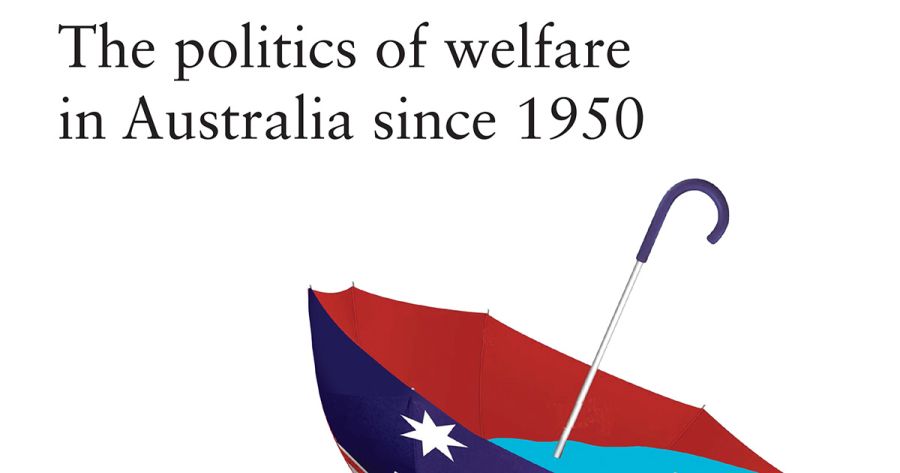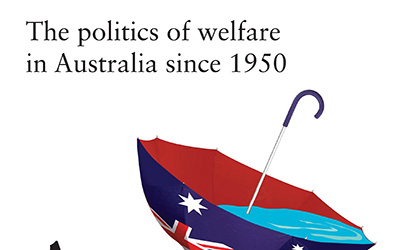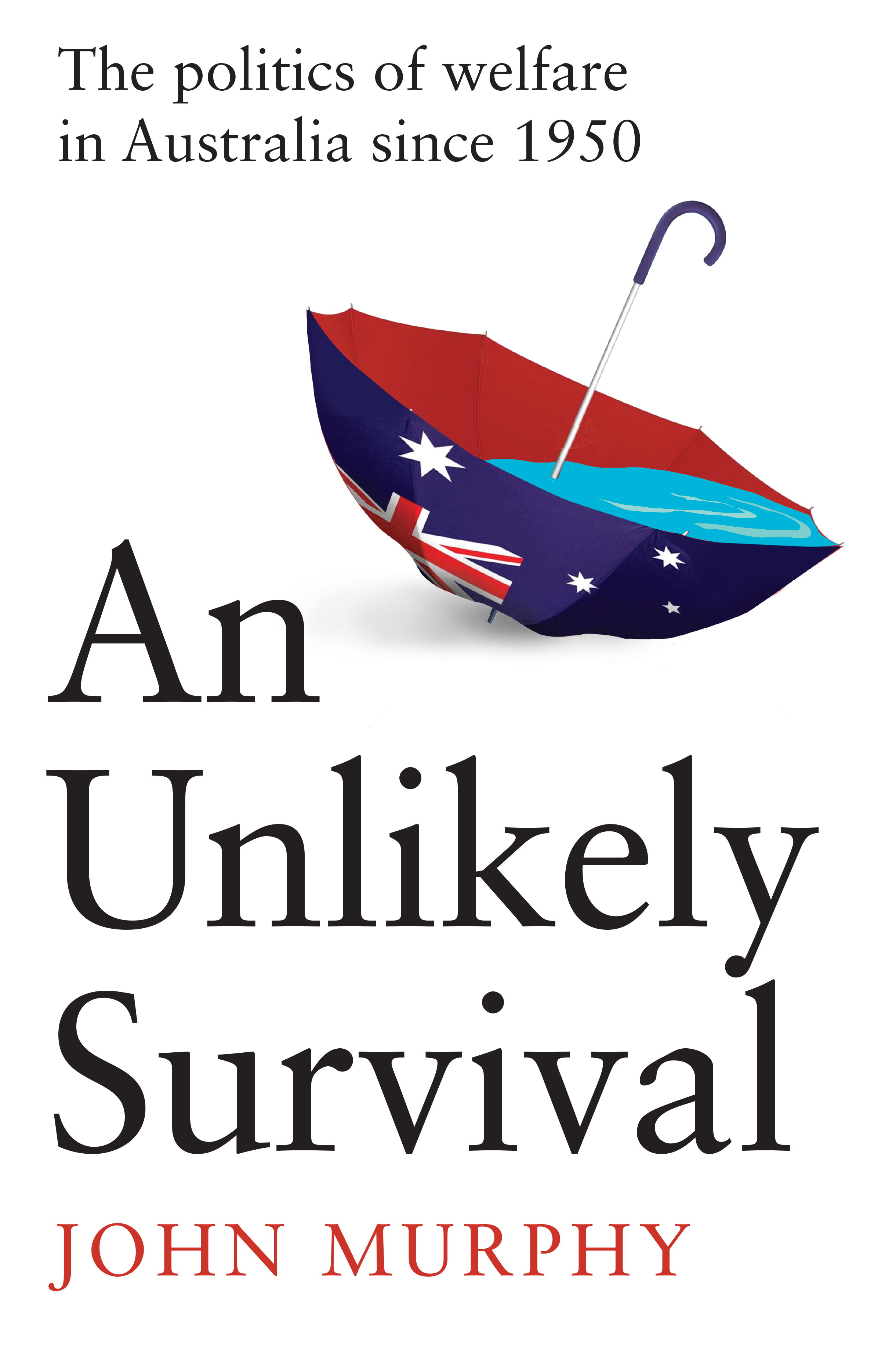
- Free Article: No
- Contents Category: Welfare
- Review Article: Yes
- Article Title: Means testing
- Article Subtitle: A landmark history of welfare politics
- Online Only: No
- Custom Highlight Text:
By the end of April 2020, more than 600,000 Australians had lost their jobs as the economy was locked down in response to the emerging Covid-19 crisis. Images of long lines queuing outside Centrelink offices inspired despondent think pieces and tweets. Here was proof of what had become of Australia’s welfare state – not quite dead but hollowed to a shell after decades of retrenchment and privatisation driven by a neo-liberal ideology embraced by both major political parties. Amid a national shutdown, the social security net appeared to have been cut to shreds.
- Featured Image (400px * 250px):

- Alt Tag (Featured Image): Ben Huf reviews ‘An Unlikely Survival: The politics of welfare in Australia since 1950’ by John Murphy
- Book 1 Title: An Unlikely Survival
- Book 1 Subtitle: The politics of welfare in Australia since 1950
- Book 1 Biblio: Melbourne University Press, $50 pb, 408 pp
- Book 1 Cover Small (400 x 600):

- Book 1 Cover (800 x 1200):

- Book 1 Readings Link: https://www.readings.com.au/product/9780522880458/an-unlikely-survival--paul-murphy--2024--9780522880458#rac:jokjjzr6ly9m
This conventional wisdom is misleading, and not just because of the significant support provided during the pandemic. In his new book, An Unlikely Survival, eminent political historian John Murphy offers a masterful account of postwar Australian welfare politics. He argues that rather than being dismantled, social policy has been remade since the 1980s to serve new ends. Survival is an appropriately ambiguous motif, complicating who we might think welfare is intended to benefit.
We typically associate welfare with payments to those in need. This is a legacy of federation-era reforms, when the new Commonwealth established age and disability pensions (1908-09) and a maternity allowance (1912), paid out of general revenue to those who met eligibility tests. These benefits were to support those not aligned with a male breadwinner, himself protected by wage arbitration, tariffs, and immigration restrictions. During World War II, a commitment to full employment and further child endowment, pensions for widows, and unemployment benefits reinforced this system. Francis Castles famously called Australia a ‘wage-earners’ welfare state’ to distinguish it from Europe’s universal social insurance schemes where welfare was not structured around household income.
Murphy picks up the story from 1950. If the postwar Liberal ascendancy was founded on Menzies’ electoral courting of the middle class, Murphy shows that welfare was key to this success, including greater access to aged pensions, the Pharmaceutical Benefits Scheme (1950), and widespread home ownership. The breadwinner’s family also benefited from tax deductions for dependent children, life and hospital insurance, private schooling, and university fees. These deductions favoured higher income earners by reducing their larger tax bills for services they could more likely afford than those on low incomes. As ‘fiscal welfare’, or tax expenditures, this support was largely invisible because it was public revenue foregone, not spent, satisfying widespread middle-class concerns to appear self-reliant.
Social change in the second half of the twentieth century altered Australian welfare. In 1959, after decades of activism, most restrictions on Indigenous Australians’ access to Commonwealth welfare benefits were removed. Increased women’s participation in the workforce, equal pay rights, and higher incidences of sole parenting also required new kinds of supports. In the 1970s and 1980s, ‘femocrats’ inside government helped establish new family allowances, childcare benefits, and the Child Support Scheme.
From the early 1970s – just as the Whitlam government attempted to make benefits universal – the global stagflation crisis of high inflation and unemployment undermined confidence in the welfare state. Murphy treats the solutions offered by the Hawke-Keating governments evenly. Yes, they deregulated labour markets – eroding the basis of the breadwinner economy – embraced austerity, tightened income tests, and outsourced social services to cut costs. But compensation for this new liberalised economy was offered with Medicare, superannuation, rental assistance, increased low-income family allowances, and training for the unemployed. Even as the privatisation of services and surveillance of welfare recipients intensified during the Howard years and beyond, this model has largely survived – perhaps constituting the ‘unlikely’ of this book’s title.
This landmark narrative history of welfare politics in post-war Australia complements Murphy’s earlier volume, A Decent Provision: Australian welfare policy, 1870 to 1949 (2011). It is also his latest instalment in a career-long engagement with twentieth-century Australian politics, including histories of 1950s Australia, the Vietnam War, and a biography of H.V. Evatt. While Murphy delves into Cabinet room policy tussles and richly enumerates who got what under different schemes, the larger political questions always remain in view.
Means testing has been the chief battleground of Australian welfare politics. Traditionally, Labor liked means testing to target the needy, while Liberals hoped to establish universal, contributory schemes to reward thriftiness. Whitlam flipped these alignments with a plan for universal superannuation (finally legislated by the Keating government in 1992), while Fraser’s Liberals embraced tighter means testing to minimise welfare spending and compel recipients to find work. This latter approach is now shared by both parties. Murphy muses that increasingly punitive means testing has fragmented Australian society, hardening indifference towards long-stigmatised recipients. The recent Robodebt tragedy, he suggests, has its origins in the Fraser-era demonisation of the dole-bludger.
In what sense has welfare ‘survived’? One indicator is Commonwealth spending. Expenditure on age and disability pensions has remained stable at around 3.5 per cent of GDP since 1975 with big increases in childcare and aged care since the 1990s. This partly reflects changing demographics but also electoral politics, with postwar politicians liberalising access to the aged pension. Since 1970, around sixty per cent of eligible Australians have been on at least a partial pension, even as some Baby Boomers have recently accrued great wealth through asset appreciation.
The changing style of delivery is also important. As the recent aged care royal commission (2018-21) concluded, for-profit welfare provision has had terrible outcomes for recipients and carers even as significant government expenditure has flowed to outsourced contractors. For all its virtues, adds Murphy, Australia’s most recent major reform, the National Disability Insurance Scheme (2013), has created another government-funded market open to ‘unscrupulous behaviours and fraud’. Meanwhile, a tireless welfare lobby, led by agencies such as ACOSS, has helped avert more virulent proposals, such as restricting unemployment benefits to finite periods.
Survival may be a misnomer. Murphy’s is ultimately a story about what became of welfare when the male breadwinner ceased to be the central figure of Australian politics. He concludes that Australian welfare was ‘refurbished’ and rightly questions whether ‘robust’ provision for low-income earners since the 1980s has sufficiently compensated for increased precarity and inequality.
But this is only half the story. Understanding welfare today requires knowing who has replaced the breadwinner. One candidate is the asset owner. As Ben Spies-Butcher has suggested, since the 1980s Australian governments have changed how they manage social risk. Rather than sustaining high wages, governments now seek to help individuals manage their finances over time by investing in assets. It is unfortunate Murphy does not continue his account of fiscal welfare beyond Menzies. If tax deductions supported the breadwinner, tax concessions underpin the new asset economy. Capital gains discounts, negative gearing, and concessional superannuation contributions are fodder in today’s debates over housing affordability and intergenerational inequality. They should also be central to debates around welfare. Those benefiting from these hidden tax expenditures are as much recipients as those visible in Centrelink queues.


Comments powered by CComment